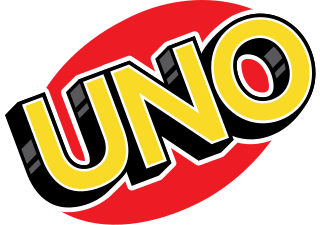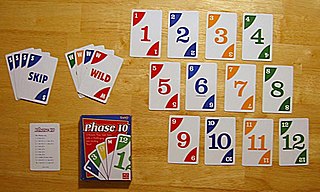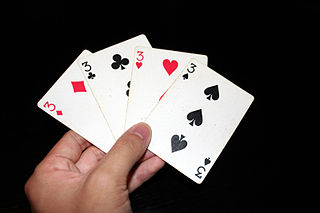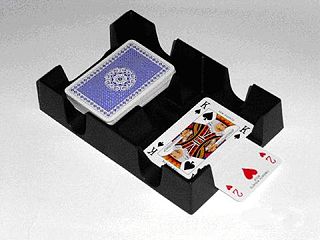Related Research Articles

Uno, stylized as UNO, is a proprietary American shedding-type card game originally developed in 1971 by Merle Robbins in Reading, Ohio, a suburb of Cincinnati, that housed International Games Inc., a gaming company acquired by Mattel on January 23, 1992.

500 rum, also called pinochle rummy, Michigan rummy, Persian rummy, rummy 500 or 500 rummy, is a popular variant of rummy. The game of canasta and several other games are believed to have developed from this popular form of rummy. The distinctive feature of 500 rum is that each player scores the value of the sets or cards they meld. It may be played by 2 to 8 players, but it is best for 3 to 5.
Spite and malice, also known as cat and mouse, is a relatively modern American card game for two or more players. It is a reworking of the late 19th-century Continental game crapette, also known as Russian bank, and is a form of competitive solitaire, with a number of variations that can be played with two or three regular decks of cards.

Doomtown: Reloaded is an expandable card game based on the Deadlands role-playing game. It was originally a collectible card game that ran from 1998 through 2001 and was revived as the Reloaded version in 2014. It was published by Wizards of the Coast (WotC) under license to Pinnacle Entertainment Group until January 2000, when WotC quit production and the license transferred to Alderac Entertainment Group.

Golf is a card game where players try to earn the lowest number of points over the course of nine deals.

Rummy is a group of games related by the feature of matching cards of the same rank or sequence and same suit. The basic goal in any form of rummy is to build melds which can be either sets or runs and either be first to go out or to amass more points than the opposition.

Sequence is an abstract strategy tabletop party game. Sequence was invented by Douglas Reuter and Hamish. They originally called the game Sequence Five. He spent years developing the concept, and, in June 1981, granted Jax Ltd. an exclusive license to manufacture, distribute and sell the board game Sequence and its subsequent variations. The game was first sold in a retail store in 1982. In 2017, Goliath Game Company bought Jax, and in early 2018 also bought all licensor rights and now owns 100% of the game Sequence. Doug Reuter is acknowledged as the inventor of Sequence on all newly produced copies of the game - both on the box and in the printed rules.
Macau, also spelled Makaua or Macaua, is a shedding-type card game from Hungary, with similar rules to Crazy Eights or Uno and uses a standard 52 card deck. The object of the game is to be the first player to remove all cards from one's hand. Macau involves bluffing so that the players can save cards for later for a higher point value. Cheating is encouraged to add additional gameplay depth.
Pitch is the American name of the English trick-taking game of Blind All Fours which, in turn, is derived from classic All Fours. Historically, Pitch started as "Blind All Fours", a very simple All Fours variant that is still played in England as a pub game. The modern game involving a bidding phase and setting back a party's score if the bid is not reached came up in the middle of the 19th century and is more precisely known as Auction Pitch or Setback.
Skip-Bo is a commercial version of the card game Spite and Malice, a derivative of Russian Bank, which in turn originates from Double Klondike. In 1967, Minnie Hazel "Skip" Bowman (1915–2001) of Brownfield, Texas, began producing a boxed edition of the game under the name SKIP-BO. In 1980 the game was purchased by International Games, which was subsequently bought by Mattel in 1992. A mobile version of the game for iOS was released by Magmic in September, 2013. There is a new version called "SKIP-BO Mod" that comes in a white and blue case.
Speed is a game for two players of the shedding family of card games, in which players try to get rid of all of their cards first. It is a form of competitive patience similar to Spit.

Phase 10 is a card game created in 1982 by Kenneth Johnson and sold by Mattel, which purchased the rights from Fundex Games in 2010. Phase 10 is based on a variant of rummy known as contract rummy. It consists of a special deck equivalent to two regular decks of cards, and can be played by two to six people. The game is named after the ten phases that a player must advance through in order to win. Many people shorten the game by aligning it to baseball rules and consider 5.5 phases to be a complete game when running out of time to complete the full ten phases. Whoever is in the lead when play stops if someone has completed 5.5 phases or more is the winner.

Contract rummy is a Rummy card game, based on gin rummy played by 3 to 8 players. It appeared in the United States during the Second World War. The game is also known as Combination rummy, Deuces Wild Rummy and Joker rummy, and a proprietary version of the game called Phase 10 was published in 1982.

Biriba is the Greek partnership version of a rummy card game of Italian origin called Pinnacola. It is played by two to six players, with two decks and 4 Jokers comprising 108 cards. If 6 players play, one more deck and two jokers more are added. Biriba can also be played by three players with or without partnership rules.
Three thirteen is a variation of the card game Rummy. It is an eleven-round game played with two or more players. It requires two decks of cards with the jokers removed. Like other Rummy games, once the hands are dealt, the remainder of the cards are placed face down on the table. The top card from the deck is flipped face up and put beside the deck to start the discard pile.
Zioncheck is a card game. It is similar to shanghai rummy, contract rummy, or phase 10. Hoyle's book of common card games describes several games as being based upon it, and Contract Rummy is believed to have originated from it.
One-card is a shedding-type card game. The general principles put it into the crazy eights family. It is played with an ordinary poker deck and the objective is for a player to empty their own hand while preventing other players from emptying theirs. The game is commonly played in South Korea, Finland and The Netherlands.
Indian Cherokee Rummy is a card game in India with little variation from original rummy. It may be considered a cross between Rummy 500 and gin rummy. Indian Rummy is a variant of the rummy game popular in India that involves making valid sets out of 13 cards that are distributed among every player on the table. Each player is dealt 13 cards initially; if the number of players is 2, then a 52 cards deck is chosen for the game and if there are 6 players, two decks of 52 cards each is combined for the game. Each player has to draw and discard cards by turns till one player melds their cards with valid sets that meet the Rummy validation rules. It could be that Indian Rummy evolved from a version of Rummy in South Asia, Celebes Rummy, also called Rhuk.
Rage is a 1983 trick-taking card game marketed by Fundex Games that is based on the game oh hell. Players bid to take a particular number of tricks, and are awarded bonus points for doing so. The commercial game differs significantly from the traditional version in the use of a proprietary deck with 6 colored suits and the addition of 6 types of special cards that change gameplay.

Guandan is a shedding-type card game that originated in Jiangsu province, China.
References
- ↑ Sackson, Sid (1982) [1969]. A Gamut of Games (2 ed.). New York: Pantheon Books. p. 216. ISBN 0-394-71115-7 . Retrieved 2024-06-10– via Internet Archive.
- ↑ Mad Magazine Card Game advertisement. Mad, Dec. 1980, p. 1
- ↑ "Mad Magazine Card Game". Mad . No. 105. July 1995. p. 34. Retrieved 2024-06-10– via Internet Archive.
- ↑ "Big game hunt in Urbandale leads kids to Parker Brothers". Des Moines Tribune . 1980-12-01. p. 216. Archived from the original on 2024-06-10. Retrieved 2024-06-10– via Newspapers.com.
- ↑ "Mad Magazine Card Game". BoardGameGeek. Retrieved 2021-02-09.